Demoscene Outreach Tour 2007
Report by Gargaj
Some of the Pictures by Gloom
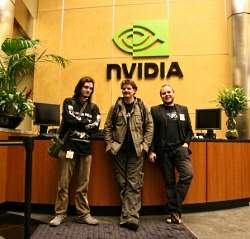 So, there was this tour: Gargaj/Conspiracy, Gloom/Excess^Portal Process from Norway and sTEELER from the Breakpoint organisation group went to America to show some of the international #1 companies (e.g. Pixar, NVIDIA, Adobe) what the demoscene is. There is a blog about it, but now you can read the report from Gargaj.
So, there was this tour: Gargaj/Conspiracy, Gloom/Excess^Portal Process from Norway and sTEELER from the Breakpoint organisation group went to America to show some of the international #1 companies (e.g. Pixar, NVIDIA, Adobe) what the demoscene is. There is a blog about it, but now you can read the report from Gargaj.
So, how this entire story began...
It started in Stuttgart, at the German FMX festival, where the demoscene had been a regular feature since 2004. I had been there the first time in 2005, I'd been there every year. Here we met Rick Sayre, one of the technical leaders of Pixar, who exhibited a strange interest in the three foolish kids who were talking about demos endlessly and dragged some hardware in showing rotating cubes on them. It turned out that he had observed the scene since the beginning of the 90's and because he also lived through those computer ages, he clearly understood the motivations behind the demos. When the end of the festival came, he suggested that we show our demos at Pixar - at this time we didn't intend to do that seriously. In August, Finland, Assembly 2007, we also met a clever member of NVIDIA, Temis Nuez, and talked with him about demos. When he gave us his name card, we realised that NVIDIA is in San Francisco too, not only Pixar. At this time it became clear where we would go in a few weeks.
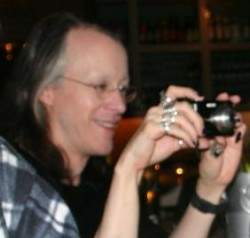 Our original plan comprised only of Pixar and Intel. Unfortunately, the latter company refused the opportunity of the connect just a few months before the trip, but thanks to Rick we got the offer to visit Industrial Light and Magic too. In the meantime Rick started to arrange his own part of the presentation and provided the opportunity for Bay Area Visual Effects Society to see the presentation - this is an organisation that connects known film studios, game developer companies and animation companies. Although this didn't mean that Steven Spielberg would see us personally, this invitation found a significant group of developers and artists. Gloom did the bigger part of organisation, he assumed the collecting of money for air tickets convincing demoscene-organisations, and providing the entering to any needful place with getting through the right people. The fact that Shiva / Kolor had moved to San Francisco one month before our trip because he started his work at Adobe came in handy for us. He offered us to stay at his habitation - obviously this helped a lot to reduce the travelling costs.
Our original plan comprised only of Pixar and Intel. Unfortunately, the latter company refused the opportunity of the connect just a few months before the trip, but thanks to Rick we got the offer to visit Industrial Light and Magic too. In the meantime Rick started to arrange his own part of the presentation and provided the opportunity for Bay Area Visual Effects Society to see the presentation - this is an organisation that connects known film studios, game developer companies and animation companies. Although this didn't mean that Steven Spielberg would see us personally, this invitation found a significant group of developers and artists. Gloom did the bigger part of organisation, he assumed the collecting of money for air tickets convincing demoscene-organisations, and providing the entering to any needful place with getting through the right people. The fact that Shiva / Kolor had moved to San Francisco one month before our trip because he started his work at Adobe came in handy for us. He offered us to stay at his habitation - obviously this helped a lot to reduce the travelling costs.
The trip started at the 27th of October, when we arrived to San Francisco. Since it was Saturday, we didn't have too many things to do except to finish our presentation thumbnails. On Sunday we looked around the city and met up with Rick, who held a solid birthday dinner with friends - my suspicions about the street had been confirmed, the street was really the Gilman Street where legendary bands like Bad Religion, Dead Kennedies and Green Day had been founded in a warehouse.
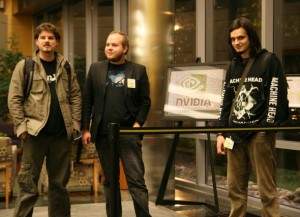 On Monday, the effective work started. We met with Temis in the morning and consulted until breakfast what we could expect from the presentation at afternoon, what NVIDIA was planning to do, which persons would be there and what was worth to emphasize. As we came to know, most of the people there had already seen demos, thanks to Temis, and could expect what the demonstration would be about. After that, we went to Santa Clara (about 70 km from San Francisco) to the headquarters of NVIDIA, where after getting an entry-badge we could notice that they had a sense for decoration: we saw some thermographies of old GPUs, and lots of their patents had been put on the wall. The presentation was shown in a little room, where after successfully configurating the sound system, the people started to come in - finally, I think, about 20 people were there.
On Monday, the effective work started. We met with Temis in the morning and consulted until breakfast what we could expect from the presentation at afternoon, what NVIDIA was planning to do, which persons would be there and what was worth to emphasize. As we came to know, most of the people there had already seen demos, thanks to Temis, and could expect what the demonstration would be about. After that, we went to Santa Clara (about 70 km from San Francisco) to the headquarters of NVIDIA, where after getting an entry-badge we could notice that they had a sense for decoration: we saw some thermographies of old GPUs, and lots of their patents had been put on the wall. The presentation was shown in a little room, where after successfully configurating the sound system, the people started to come in - finally, I think, about 20 people were there.
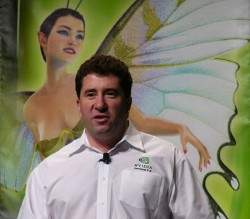 The most relevant member of the fellowship may be Rob Csongor, the marketing-president, who, as it can be guessed from his name, has Hungarian roots, and when he discovered that I'm Hungarian too, he welcomed me with a "hi, me too speaks Hungarian" smile, and said that his grandfather always said to him: "I give you such a slap, that you sit down". Our performance, as it was the first time we held it, was a little bit difficult but not keenless - we wanted to show both the cultural and the technical part of the demoscene and felt that the people were surely interested in this alternative type of art, which is able to show the good capabilities of their hardware. After our speech, Rob continued and we started to feel that such a lot of people hadn't come here only at a venture - Rob almost brought concrete plans and ideas about making an abiding coproduction by the demoscene and NVIDIA. This was perfectly suitable for our plans - the target was making partnerships with these companies that would guarantee the help of organisation, sponsoring the parties and so on, for years to come. For this we needed to understand what were each other's interests in it.
The most relevant member of the fellowship may be Rob Csongor, the marketing-president, who, as it can be guessed from his name, has Hungarian roots, and when he discovered that I'm Hungarian too, he welcomed me with a "hi, me too speaks Hungarian" smile, and said that his grandfather always said to him: "I give you such a slap, that you sit down". Our performance, as it was the first time we held it, was a little bit difficult but not keenless - we wanted to show both the cultural and the technical part of the demoscene and felt that the people were surely interested in this alternative type of art, which is able to show the good capabilities of their hardware. After our speech, Rob continued and we started to feel that such a lot of people hadn't come here only at a venture - Rob almost brought concrete plans and ideas about making an abiding coproduction by the demoscene and NVIDIA. This was perfectly suitable for our plans - the target was making partnerships with these companies that would guarantee the help of organisation, sponsoring the parties and so on, for years to come. For this we needed to understand what were each other's interests in it.
It was important to make clear that we did not come for
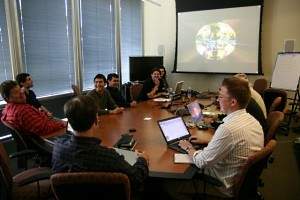
money and the entire demoscene is a hobby/lifestyle/being form, they also emphasized it for NVIDIA, although seemingly that would be logical, it's not their interest to sell more video cards. In a segment with one or two companies the market share isn't the only important factor and if they vainly advertised their stuff directly on the demoparties, the people wouldn't decide due to it, because companies couldn't affect the sceners with advertisements. Their conception was to know such people who can show the abilities of their hardware and can present what the company makes with a good impression, because it counts a lot more than taking posters. The afternoon presentation lasted until far in the evening and we agreed that we would come back to them on another day because they wanted more consultation with us. At this point a sudden event occured, a short earthquake of 5.6 degree, which was unexpected not only for us Europeans, but for the local American people too - we had asked the day before how often it happened, and they had said never. The earthquake was followed by a short chat, during which we were giving away some previously purchased MindCandy discs and discovered someone who is a coder of the French group Epidemic and had been at Breakpoint 2003. Enthusiastic about this, we went to the town for a beer.
 Next day, the forthcoming targets were the ILM and LucasFilm/LucasArts; there wasn't any plan since we knew only a few people from there. So we regarded the presentation as a haphazard. This feeling was intensified by the experience of seeing a life-sized Darth Vader watching us from the corner. As we didn't have much time, we quickly slammed our stuff for the performance in the middle of packing and connected it to the local AV connectors. After a short test we were ready - since there was little time, someone from the chamber said, that he would put in some demoreel... About the ILM demoreels we have to know that they aren't simple. These demoreels shocked us a bit, our first thought was "Why are we here at all?", but thanks God, our old pal AND had just arrived, who, as it turned out, had been working for LucasArts on the new Indiana Jones game for not a long time and for this reason, he had to learn the English language too.
Next day, the forthcoming targets were the ILM and LucasFilm/LucasArts; there wasn't any plan since we knew only a few people from there. So we regarded the presentation as a haphazard. This feeling was intensified by the experience of seeing a life-sized Darth Vader watching us from the corner. As we didn't have much time, we quickly slammed our stuff for the performance in the middle of packing and connected it to the local AV connectors. After a short test we were ready - since there was little time, someone from the chamber said, that he would put in some demoreel... About the ILM demoreels we have to know that they aren't simple. These demoreels shocked us a bit, our first thought was "Why are we here at all?", but thanks God, our old pal AND had just arrived, who, as it turned out, had been working for LucasArts on the new Indiana Jones game for not a long time and for this reason, he had to learn the English language too.
With a familiar face on the event, we could be eased a bit. After the audience had arrived, we started the presentation, which in my opinion in the end became the most successful presentation from the iterations, although there was an ugly technical failure after Track One, the crash of Debris. (Seeing Track One the
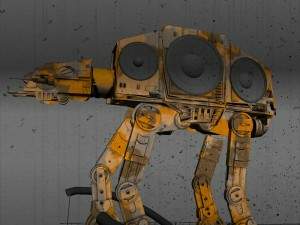
audience malevolently smirked because of the AT-AT, just like they did at the stone-ball Indy part in Untitled.) Between the questions we were surprised when somebody in French accent announced that "in former times that was so..." and "it's important to mention that...". Our further asking cleared that he was Nitch/Nooon, the less famous coder of the legendary Nooon, who still regretted that he hadn't contributed code to Stars and thought about starting to make something with the bunch of Java effects which he had been collecting for years.
The presentation ended in a usual form. Lots of people came to ask (with one saying "I am Hungarian too, I was at home, Budapest, last year"), where they can download more demos. After hearing the warning that the canteen would be closed in a short time, the bigger part of the crowd went to the lunchroom, where the storytelling continued, and after one of my unguarded half-sentences I realized that a kind, smiling 50-year-old man was standing near me, holding a USB drive, saying he would be grateful if I could copy demos to it for him. Another interesting moment was, when forgetting ourselves, we started to talk in scene-dialect between people, using the word "graphician", which is not an official English word; one of the colleagues from ILM

paid attention and said he liked this word so much that he decided to change his self-description to this word, instead of "graphic artist". The rest of the day at ILM was spent by looking around in the building, which was a weird experience for someone who had seen most of the films released by them. There were Simer from the Ghostbusters, Han Solo frozen to carbonit, R2D2, Draco from Dragonheart, paintings form the Die Hard 2, the original starship from Cocoon in the show-cases, together with ALL of the posters of films made with ILM's help... The "what am I doing here?" feeling appeared again, although our leader, Josh, confirmed me, that since he had the task of organizing such presentations at the company, he could say with certainty that our show was the most interesting one for the people, and there were most people on it. After this, we went home and prepared for our first "authentic" halloween-party to which we were invited by Rick, and it turned out that it was REALLY like in the films (children rushing in idiot costumes on the street with torches and nylon bags).
On Wednesday we would have originally started with Intel, but

they had cancelled the meeting, so we wouldn't have any task except the second part of the NVIDIA meeting in the evening if Shiva hadn't said on the previous day that he had talked to his bosses, and we could make a quick presentation to the Flash developers at lunch time. Of course we made the best of the chance and fixed a little bit on our presentation and travelled (after getting lost a several times) to Adobe, where the people sat in line, waiting for us, looking forward to watching demos until lunch. (Oops.) In behalf of them we put some Flash-demos onto the presented demoshow, then came questions like "It is AS3, isn't it?" and the sensible satisfaction that their stuff can do the same effects. An interesting question came from an afro-haired, spectacled programmer, who asked us how strong was the connection between demo-making and psychedelic drugs - we tried to avoid answering by asking the audience to give a tip, how much space the demo allocated - they gave tips between 5 and 1 megabytes, although the hints about 1 megabyte came diffidently, probably for the reaction to the smirk on our faces. When we switched back on the projector to the Windows (File) Explorer, the concordant reaction was a "noooo...". The audience seemed very keen, someone said that he had written a bunch of Winamp visualisations and had never felt that they would have any use, but in this way everything seemed much more logical to him and maybe he would be going to start some demo-coding.

Leaving Adobe, after a little breath-catching, we went back to the road 101, directed to NVIDIA, where we discovered that the campus was a little bit bigger than what we had first seen, with lots of sections on the three buildings (although, when we asked where was the driver-developer section, they only said "it's on a secure place"), and near the buffet ("n Street Cafe") with a seriously used ping-pong table. (The president of NVIDIA, Jen-Hsun Huang aka. Jensen was a junior ping-pong champion). After some coffee, we landed in a tiny room, going to the same table where Alain Tiquet was, who is one of the company marketing team leaders. Unfortunately I have to interrupt writing about that part, because it's temporarily a non-public conversation, but in the following 1-2 months everything will emerge. In short, an incredible bunch of information had been exchanged among us and if everything goes fine that will be a great sensation.
On Thursday, the day came when we travelled to Pixar, which we found after a short range and a just-in-time avoided car accident. Our first impression rose at once at the car entrance when we noticed the entering system: While the NVIDIA building
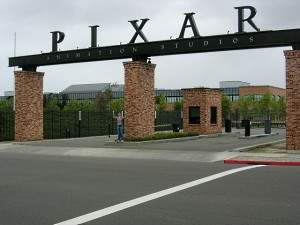
was a transparent classic office building with an NVIDIA logo at the top of it, and the ILM one was rather similar to a park, the Pixar one started with a hedge and an entrance system that had at its top a huge company name advertisement, then inside the logo of 'Cars' animation production advertisements, which was the parking direction. The building was a two-part-separated huge pile, in the left part of it, the programmers and engineers, in the right part, the graphicians and artists were working. The whole building reminded of a fairy tale castle: drawings, concepts, conceptarts, designs, texts ("If the films are prose, the short films are poetry"), the pieces of the Pixar history. On the left on the window of the render farm, the brackets were accurately in queue, about 50 short glasses, near them 64 MB RAM from 1986, from 2001 and from 2006 on the wall, exponentially decreasing in size. Back in another room was the old laser-based image mastering box, with the size of around a sofa - it was said to be in working condition.
On the other side, there were the original sculptures, drawings, the short description of Joe Ranft about storyboarding in storyboard style and of course the well known "office culture": on the one side there were the office blocks as can see in

American films, where the people were working, and on the other side there were mushroom houses with garden gnomes or medieval laboratories. The two sides of the building were connected by a tiny wooden made bridge, where origami paper airplane races were organised yearly. After passing around the main part of the building, we walked near the swimming pool to the developing centre, where we started our real excercise - we first met Pixar's R&D team, which was rather courious about the technical details of the demos so we compressed the contents of our talk and I quickly held a short "how-the-64k-was-made" show with aDDict2, followed by mere success.
Jekyll / Andromeda was a member of that team, who - as it turned out, his co-workers didn't know - was also a scener so we quickly discovered his past to the delight of the team. A further little nice affair happened when the previous discovery had been mentioned, at the Adobe someone said that he would be keen on making demos, others intently looked at each other and told such things that "we can't afford them to make it first" - certainly, I truly wouldn't expect a Pixar demo in the following 15 years, but that was funny anyway.
Our little souvenir debuted here for the first time to the "target public", the "Luxo 4k", the classical Pixar intro-animation pressed
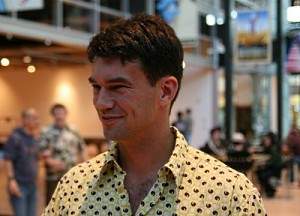
to 4k by IQ/RGBA and by myself. Obviously our target wasn't the force-demonstrating to a world company, but we definitely felt obliged thereby they invited us so we made this intro to thank they efforts. IQ was the responsible of making the intro in 90%, I only assembled the sound for it in the last minute, and unfortunately it overflew above the size limit, so when we arrived to Pixar, it was rather 4.5k than 4k, but we thought that this didn't matter for this time. The reactions wasn't so smashing, but certainly they looked strangely at the final file size, with the face expression of a mother when seeing her 6-month-old child floating the cutleries telekinetically while playing the piano.
The second consultation was much more formal, with Robin MacDonald, who is a recruiter of the company and wanted to help the future of the demoscene, while he was keen on this genre of art. In other words he wanted to arrange to allow sceners go to work at Pixar for several months, because the experience showed that somebody who had a reference about the demoscene in his resume, usually produced reliable quality and had serious experiences in a lot of aspects. On the other side, it is said that working with sceners can be so difficult in this industry. Anyway, we will work on this option to happen.
When the conversation finished, the Pixar Friday Beer Bash was

already elapsing, which is a Friday afternoon beer gathering, preparing for the weekend, at the big hall. For encouragement, we tooksome glass of it, prepared for the technical details and assembled the stuff for the presentation. After half an hour, people arrived, and although they were not more than 50 persons, the fellowship was much more diverse than before. The exhibition passed relatively smoothly and despite it wasn't the best, the reactions were excellent and everybody was amazed when seeing the Luxo 4k. Rick simply smiled gently, as if he wasnn't surprised. The most beautiful part of this event was the little talking after this, and Pyro / HJB arrived too, followed by an Asian man with an Australian dialect, who asked us about the sceners making music, after answering, he mentioned that he had written a tracker, the Impulse Tracker... As it cleared, Jeffrey was around in the neighbourhood and some of his acquaintances had told him about our presentation. The strange fact was that we were not the center of the event, people talked in little groups of 3-4 about what they had coded long before, and what they swapped with.
As you can see, after all - "connecting people".
Links related to this article
Demoscene Outreach Tour 2007 blog
http://demotrip.blogspot.com
This article was originally published on www.scene.hu in the Hungarian
language.
Thanks to Gargaj for allowing us to publish his report in Hugi#34.
 So, there was this tour: Gargaj/Conspiracy, Gloom/Excess^Portal Process from Norway and sTEELER from the Breakpoint organisation group went to America to show some of the international #1 companies (e.g. Pixar, NVIDIA, Adobe) what the demoscene is. There is a blog about it, but now you can read the report from Gargaj.
So, there was this tour: Gargaj/Conspiracy, Gloom/Excess^Portal Process from Norway and sTEELER from the Breakpoint organisation group went to America to show some of the international #1 companies (e.g. Pixar, NVIDIA, Adobe) what the demoscene is. There is a blog about it, but now you can read the report from Gargaj.
 Our original plan comprised only of Pixar and Intel. Unfortunately, the latter company refused the opportunity of the connect just a few months before the trip, but thanks to Rick we got the offer to visit Industrial Light and Magic too. In the meantime Rick started to arrange his own part of the presentation and provided the opportunity for Bay Area Visual Effects Society to see the presentation - this is an organisation that connects known film studios, game developer companies and animation companies. Although this didn't mean that Steven Spielberg would see us personally, this invitation found a significant group of developers and artists. Gloom did the bigger part of organisation, he assumed the collecting of money for air tickets convincing demoscene-organisations, and providing the entering to any needful place with getting through the right people. The fact that Shiva / Kolor had moved to San Francisco one month before our trip because he started his work at Adobe came in handy for us. He offered us to stay at his habitation - obviously this helped a lot to reduce the travelling costs.
Our original plan comprised only of Pixar and Intel. Unfortunately, the latter company refused the opportunity of the connect just a few months before the trip, but thanks to Rick we got the offer to visit Industrial Light and Magic too. In the meantime Rick started to arrange his own part of the presentation and provided the opportunity for Bay Area Visual Effects Society to see the presentation - this is an organisation that connects known film studios, game developer companies and animation companies. Although this didn't mean that Steven Spielberg would see us personally, this invitation found a significant group of developers and artists. Gloom did the bigger part of organisation, he assumed the collecting of money for air tickets convincing demoscene-organisations, and providing the entering to any needful place with getting through the right people. The fact that Shiva / Kolor had moved to San Francisco one month before our trip because he started his work at Adobe came in handy for us. He offered us to stay at his habitation - obviously this helped a lot to reduce the travelling costs.
 On Monday, the effective work started. We met with Temis in the morning and consulted until breakfast what we could expect from the presentation at afternoon, what NVIDIA was planning to do, which persons would be there and what was worth to emphasize. As we came to know, most of the people there had already seen demos, thanks to Temis, and could expect what the demonstration would be about. After that, we went to Santa Clara (about 70 km from San Francisco) to the headquarters of NVIDIA, where after getting an entry-badge we could notice that they had a sense for decoration: we saw some thermographies of old GPUs, and lots of their patents had been put on the wall. The presentation was shown in a little room, where after successfully configurating the sound system, the people started to come in - finally, I think, about 20 people were there.
On Monday, the effective work started. We met with Temis in the morning and consulted until breakfast what we could expect from the presentation at afternoon, what NVIDIA was planning to do, which persons would be there and what was worth to emphasize. As we came to know, most of the people there had already seen demos, thanks to Temis, and could expect what the demonstration would be about. After that, we went to Santa Clara (about 70 km from San Francisco) to the headquarters of NVIDIA, where after getting an entry-badge we could notice that they had a sense for decoration: we saw some thermographies of old GPUs, and lots of their patents had been put on the wall. The presentation was shown in a little room, where after successfully configurating the sound system, the people started to come in - finally, I think, about 20 people were there.
 The most relevant member of the fellowship may be Rob Csongor, the marketing-president, who, as it can be guessed from his name, has Hungarian roots, and when he discovered that I'm Hungarian too, he welcomed me with a "hi, me too speaks Hungarian" smile, and said that his grandfather always said to him: "I give you such a slap, that you sit down". Our performance, as it was the first time we held it, was a little bit difficult but not keenless - we wanted to show both the cultural and the technical part of the demoscene and felt that the people were surely interested in this alternative type of art, which is able to show the good capabilities of their hardware. After our speech, Rob continued and we started to feel that such a lot of people hadn't come here only at a venture - Rob almost brought concrete plans and ideas about making an abiding coproduction by the demoscene and NVIDIA. This was perfectly suitable for our plans - the target was making partnerships with these companies that would guarantee the help of organisation, sponsoring the parties and so on, for years to come. For this we needed to understand what were each other's interests in it.
The most relevant member of the fellowship may be Rob Csongor, the marketing-president, who, as it can be guessed from his name, has Hungarian roots, and when he discovered that I'm Hungarian too, he welcomed me with a "hi, me too speaks Hungarian" smile, and said that his grandfather always said to him: "I give you such a slap, that you sit down". Our performance, as it was the first time we held it, was a little bit difficult but not keenless - we wanted to show both the cultural and the technical part of the demoscene and felt that the people were surely interested in this alternative type of art, which is able to show the good capabilities of their hardware. After our speech, Rob continued and we started to feel that such a lot of people hadn't come here only at a venture - Rob almost brought concrete plans and ideas about making an abiding coproduction by the demoscene and NVIDIA. This was perfectly suitable for our plans - the target was making partnerships with these companies that would guarantee the help of organisation, sponsoring the parties and so on, for years to come. For this we needed to understand what were each other's interests in it.

 Next day, the forthcoming targets were the ILM and LucasFilm/LucasArts; there wasn't any plan since we knew only a few people from there. So we regarded the presentation as a haphazard. This feeling was intensified by the experience of seeing a life-sized Darth Vader watching us from the corner. As we didn't have much time, we quickly slammed our stuff for the performance in the middle of packing and connected it to the local AV connectors. After a short test we were ready - since there was little time, someone from the chamber said, that he would put in some demoreel... About the ILM demoreels we have to know that they aren't simple. These demoreels shocked us a bit, our first thought was "Why are we here at all?", but thanks God, our old pal AND had just arrived, who, as it turned out, had been working for LucasArts on the new Indiana Jones game for not a long time and for this reason, he had to learn the English language too.
Next day, the forthcoming targets were the ILM and LucasFilm/LucasArts; there wasn't any plan since we knew only a few people from there. So we regarded the presentation as a haphazard. This feeling was intensified by the experience of seeing a life-sized Darth Vader watching us from the corner. As we didn't have much time, we quickly slammed our stuff for the performance in the middle of packing and connected it to the local AV connectors. After a short test we were ready - since there was little time, someone from the chamber said, that he would put in some demoreel... About the ILM demoreels we have to know that they aren't simple. These demoreels shocked us a bit, our first thought was "Why are we here at all?", but thanks God, our old pal AND had just arrived, who, as it turned out, had been working for LucasArts on the new Indiana Jones game for not a long time and for this reason, he had to learn the English language too.







